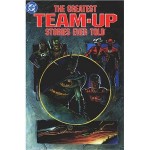
By various (DC Comics)
ISBN: 0-930289-51-X
When the very concept of high priced graphic novels was just being tested in the early 1990s DC Comics produced a line of glorious hardback compilations spotlighting star characters and celebrating standout stories from the company’s illustrious and varied history decade by decade. They even branched out into themed collections which shaped the output of the industry to this day.
The Greatest Stories collections were revived this century as smaller paperback editions (with mostly differing content) and stand as an impressive and joyous introduction to the fantastic worlds and exploits of the World’s Greatest Superheroes. However for sheer physical satisfaction the older, larger books are by far the better product. Some of them made it to softcover trade paperback editions, but if you can afford it, the big hard ones are the jobs to go for…
From the moment a kid first sees his second superhero the only thing he/she wants is to see how the new costumed marvel stacks up against the first. From the earliest days of the industry (and according to Julie Schwartz’s fascinating introduction here, it was the same with the pulps and dime novels that preceded them) we’ve wanted our idols to meet, associate, battle together – and if you follow the Timely/Marvel model, that means against each other – far more than we want to see them trounce their archenemy one more time…
The Greatest Team-Up Stories Ever Told gathers together a stunning variety of classic tales and a few less famous but still worthy aggregations of heroes, but cleverly kicks off with a union of bad-guys in the Wayne Boring illustrated tale ‘The Terrible Trio!’ (Superman #88, March 1954) as the Man of Steel’s wiliest foes, Lex Luthor, Toyman and the Prankster joined forces to outwit and destroy him, whilst World’s Finest Comics #82 (May-June 1956) saw Batman and Robin join the Man of Tomorrow in a time-travelling romp to 17th century France as ‘The Three Super-Musketeers!’, helping embattled D’Artagnan solve the mystery of the Man in the Iron Mask.
A lot of these stories are regrettably uncredited, but nobody could miss the stunning artwork of Dick Sprang here, and subsequent research has since revealed writer Edmond Hamilton and inker Stan Kaye were also involved in crafting this terrific yarn.
Kid heroes prevailed when Superman was murdered and the Boy Wonder travelled back in time to enlist the victim’s younger self in ‘Superboy Meets Robin’ (Adventure Comics #253, October 1953) illustrated by Al Plastino, whilst two of that title’s venerable back-up stars almost collided in an experimental crossover from issue #267 (December 1959).
At this time Adventure starred Superboy and featured Aquaman and Green Arrow as supporting features. ‘The Manhunt on Land’, with art from Ramona Fradon & Charles Paris, saw villainous Shark Norton trade territories with Green Arrow’s foe The Wizard. Both parts were written by Robert Bernstein, and the two heroes and their sidekicks worked the same case with Aquaman fighting on dry land whilst the Emerald Archer pursued his enemy beneath the waves in his own strip; ‘The Underwater Archers’, illustrated by the excellent Lee Elias.
As I’ve mentioned before, I was one of the “Baby Boomer†crowd who grew up with Gardner Fox and John Broome’s tantalisingly slow reintroduction of Golden Age superheroes during the halcyon, eternally summery days of the 1960s. To me those fascinating counterpart crusaders from Earth-Two weren’t vague and distant memories rubber-stamped by parents or older brothers – they were cool, fascinating and enigmatically new. And for some reason the “proper†heroes of Earth-One held them in high regard and treated them with obvious deference…
It all began, naturally enough, in The Flash, flagship title of the Silver Age Revolution. After ushering in the triumphant return of the costumed superhero, the Scarlet Speedster, with Fox and Broome at the reins, set an unbelievably high standard for metahuman adventure in sharp, witty tales of science and imagination, illustrated with captivating style and clean simplicity by Carmine Infantino.
Fox didn’t write many Flash scripts at this time, but those few he did were all dynamite. None more so than the full-length epic that literally changed the scope of American comics forever. ‘Flash of Two Worlds’ (Flash #123 September 1961, illustrated by Infantino and Joe Giella) introduced alternate Earths to the continuity which resulted in the multiversal structure of the DCU, Crisis on Infinite Earths and all succeeding cosmos-shaking crossover sagas since. And of course where DC led, others followed…
During a benefit gig Flash (police scientist Barry Allen) accidentally slips into another dimension where he finds the comic-book champion he based his own superhero identity upon actually exists. Every adventure he’d avidly absorbed as an eager child was grim reality to Jay Garrick and his mystery-men comrades on the controversially named Earth-2. Locating his idol Barry convinces the elder to come out of retirement just as three Golden Age villains, Shade, Thinker and the Fiddler make their own wicked comeback… Thus is history made and above all else, ‘Flash of Two Worlds’ is still a magical tale that can electrify today’s reader.
The story generated an avalanche of popular and critical approval (big sales figures, too) so after a few more trans-dimensional test runs the ultimate team-up was delivered to slavering fans. ‘Crisis on Earth-One’ (Justice League of America #21, August 1963) and ‘Crisis on Earth-Two’ (#22) combine to become one of the most important stories in DC history and arguably one of the most important tales in American comics. When ‘Flash of Two Worlds’ introduced the concept of Infinite Earths and multiple heroes to the public, pressure had begun almost instantly to bring back the actual heroes of the “Golden Ageâ€. Editorial powers-that-be were hesitant, though, fearing too many heroes would be silly and unmanageable, or worse yet put readers off. If they could see us now…
The story by Fox, Mike Sekowsky Bernard Sachs finds a coalition of assorted villains from each Earth plundering at will and trapping the mighty Justice League in their own HQ. Temporarily helpless the heroes contrive a desperate plan to combine forces with the champions of a bygone era and the result is pure comicbook majesty. It’s impossible for me to be totally objective about this saga. I was a drooling kid in short trousers when I first read it and the thrills haven’t diminished with this umpty-first re-reading. This is what superhero comics are all about!
The wonderment continues here with a science fiction hero team-up from Mystery in Space #90, which had been the home of star-spanning Adam Strange since issue #53 and with #87 Schwartz moved Hawkman and Hawkgirl into the back-up slot, and even granted them occasional cover-privileges before they graduated to their own title. These were brief, engaging action pieces but issue #90 (March 1964) was a full-length mystery thriller pairing the Winged Wonders and Earth’s interplanetary expatriate in a spectacular End-of the-World(s) epic.
‘Planets in Peril!’ written by Fox, illustrated by Carmine Infantino and Murphy Anderson, found our fragile globe instantly transported to the Alpha-Centauri system and heading for a fatal collision with the constantly-under-threat world of Rann at the behest of a scientific madman who eventually proved no match for the high-flying, rocket-powered trio.
Before settling into a comfortable pattern as a Batman team-up title, Brave and the Bold had been a high-adventure anthology, a try-out book like Showcase and a floating team title, pairing disparate heroes together for one-off adventures. One of the very best of these was ‘The Challenge of the Expanding World’ (#53, April-May 1964) in which the Atom and Flash strove valiantly to free a sub-atomic civilisation from a mad dictator and simultaneously battled to keep that miniature planet from explosively enlarging into our own.
This astounding thriller from Bob Haney and the incredible Alex Toth was followed in the next B&B issue by the origin of the Teen Titans and that event is repeated here. ‘The Thousand-and-One Dooms of Mr. Twister’ (#54, June-July 1964) by Haney, Bruno Premiani and Charles Paris united sidekicks Kid Flash, Aqualad and Robin the Boy Wonder in a desperate battle against a modern wizard-come-Pied Piper who had stolen the teen-agers of American everytown Hatton Corners. The young heroes had met in the town by chance when students invited them to mediate in a long-running dispute with the town adults, but didn’t even have a team name until their second appearance.
By the end of the 1960s America was a bubbling cauldron of social turmoil and experimentation. Everything was challenged and with issue #76 of Green Lantern, Denny O’Neil and comics iconoclast Neal Adams completely redefined contemporary superhero strips with relevancy-driven stories that transformed moribund establishment super-cops into questing champions and explorers of the revolution. ‘No Evil Shall Escape My Sight!’ (O’Neil, Adams & Frank Giacoica, April 1970) is a landmark in the medium, utterly re-positioning the very concept of the costumed crusader as ardent liberal Green Arrow challenges GL’s cosy worldview as the heroes discover true villainy can wear business suits, harm people just because of skin colour and happily poison its own nest for short term gain…
Of course the fact that the story is a brilliant crime-thriller with science-fiction overtones beautifully illustrated doesn’t hurt either…
The Fabulous World of Krypton was a long-running back-up feature in Superman during the 1970s, revealing intriguing glimpses from the history of that lost world. One of the very best is ‘The Greatest Green Lantern of All’ (#257, October, 1972 by Elliot Maggin, Dick Dillin & Dick Giordano) detailing the tragic failure of avian GL Tomar-Re, dispatched to prevent the planet’s detonation and how the Guardians of the Universe had planned to use that world’s greatest bloodline…
Brave and the Bold produced a plethora of tempestuous team-ups starring Batman and his many associates, and at first glance ‘Paperchase’ (#178, September 1981) by Alan Brennert & Jim Aparo from the dying days of the title might seem an odd choice, but don’t be fooled. This pell-mell pairing of Dark Knight and the Creeper in pursuit of an uncanny serial killer is tension-packed, turbo-charged thriller of intoxicating quality.
The narrative section of this collaborative chronicle concludes with the greatest and most influential comics writer of the 1980s, combining his signature character with DC guiding icon for a moody, melancholy masterpiece of horror-tinged melodrama. From DC Comics Presents #85 (September 1985) comes ‘The Jungle Line’ by Alan Moore, Rick Veitch & Al Williamson wherein Superman contracts a fatal disease from a Kryptonian spore and plagued by intermittent powerlessness, oncoming madness and inevitable death, deserts his loved ones and drives slowly south to die in isolation.
Mercifully in the dark green swamps he is found by the world’s plant elemental the Swamp Thing…
The book is edited by Mike Gold, Brian Augustyn & Robert Greenberger, with panoramic and comprehensive endpaper illustrations from Carmine Infantino (who blue-printed the Silver Age of Comicbooks) and text features ‘The Ghosts of Frank and Dick Merriwell’, ‘That Old Time Magic’ and a captivating end-note article ‘Just Imagine, Your Favourite Heroes…’. However for fans of all ages possibly the most beguiling feature in this volume is the tantalising cover reproduction section: team-ups that didn’t make it into this selection, filling in all the half-page breaks which advertised new comics in the originals. I defy any nostalgia-soaked fan not to start muttering “got; got; need it; Mother threw it away…â€
This unbelievably enchanting collection is a pure package of superhero magnificence: fun-filled, action-packed and utterly addictive.
© 1954-1985, 1989 DC Comics Inc. All Rights Reserved.

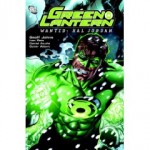
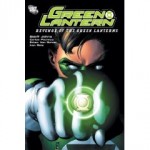
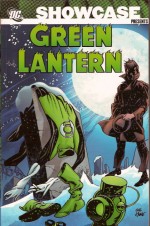
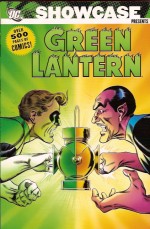

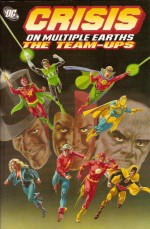
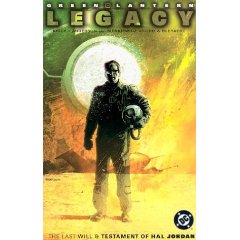
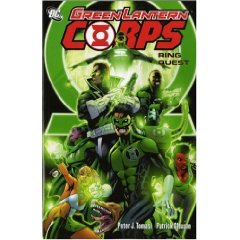
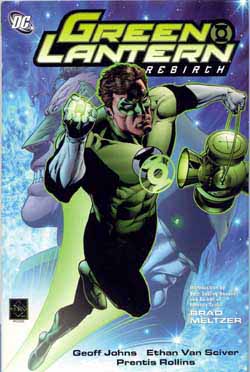 Â
Â